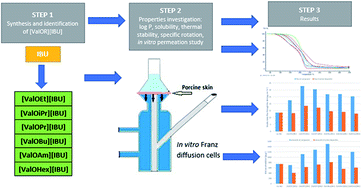Enhancement of ibuprofen solubility and skin permeation by conjugation with l-valine alkyl esters†
Abstract
New ibuprofen derivatives were made via conjugation with L-valine alkyl esters (ValOR), where R was changed from an ethyl to a hexyl group. The ionic structure was confirmed using NMR and FTIR. Specific rotation, solubility in commonly used solvents, thermal properties including phase transitions temperatures, and thermal stability were also determined. The ionic structure with a protonated amine group on an L-valine ester and melting points below 100 °C allowed inclusion of these ibuprofen derivatives into the pharmaceutically active protic ionic liquids. The ibuprofen salt solubility in deionised water and two buffer solutions at pH 5.4 and 7.4 were established and compared with the parent acid solubility. The octanol/water (buffer) partition coefficient, permeation through porcine skin, and accumulation in the skin were also measured. Ibuprofen pairing with L-valine alkyl esters [ValOR][IBU], caused higher solubility and a greater drug molecule absorption through biological membranes. log P was lower for ibuprofen salts than for the acid and it increased with a longer L-valine ester cation alkyl chain. In vitro porcine skin tests showed that ibuprofen salts with a propyl or isopropyl ester in L-valine are particularly relevant for topical application. They provide transport for ibuprofen through the skin at much higher rate than the unmodified acid and a higher permeated ibuprofen concentration, which can improve efficacy. Thus, synthesised ibuprofen derivatives could be used as drug carriers in transdermal systems to provide better drug bioavailability, and they can be also be the source of exogenous L-valine.



 Please wait while we load your content...
Please wait while we load your content...